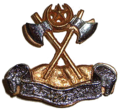
The tabar (also called tabarzin, which means "saddle axe" [in persian], Persian: تبر) is a type of battle axe. The term tabar is used for axes originating from the Ottoman Empire, Persia, India and surrounding countries and cultures. As a loanword taken through Iranian Scythian, the word tabar is also used in most Slavic languages as the word for axe[1] (e.g. Russian: топор).
YouTube Encyclopedic
-
1/2Views:329631
-
Axe vs Anglo Norman Mace
-
Battle Axe “Teber” – Savaş Baltası
Transcription
Persia
The tabarzin (saddle axe) (Persian: تبرزین; sometimes translated "saddle-hatchet") is the traditional battle axe of Persia (Iran). It bears one or two crescent-shaped blades. The long form of the tabar was about seven feet long, while a shorter version was about three feet long. What makes the Persian axe unique is the very thin handle, which is very light and always metallic.[2] The tabarzin was sometimes carried as a symbolic weapon by wandering dervishes (Muslim ascetic worshippers).[citation needed] The word tabar for axe was directly borrowed into Armenian as tapar (Armenian: տապար) from Middle Persian tabar,[3][4] as well as into Proto-Slavic as "topor" (*toporъ), the latter word known to be taken through Scythian,[5][1] and is still the common Slavic word for axe.[1]
India
During the 17th and 18th centuries, the tabar battle axe was a standard weapon of the mounted warriors of Punjab, Sikh Khalsa army and what is now modern day India and Pakistan. Made entirely of metal or with a wood haft, it had a strongly curved blade and a hammer-headed poll and was often decorated with scroll work. Sometimes a small knife was inserted in the tabar's hollow haft.
Arabia
According to Adam Metz's "Islamic Civilization in the Fourth Century of the Hegira," the tabar was frequently not only a weapon used by police chiefs (Sahib al-Shurta), but also a mark of office for them.
Gallery
-
Indian (Southern) tabar (axe), 18th century, the wooden haft has a steel tang running 3/4 of the way down, pinned by four rivets. The axe head is brass with a forged steel blade, L. 58 cm.
-
Indian tabar-zaghnal, a combination tabar axe and zaghnal war hammer - pick, all-steel construction, 18th to 19th century
-
Indian (Deccan) tabar-shishpar, an extremely rare combination tabar axe and shishpar eight-flanged mace, steel with hollow shaft, 21.75 inches, 17th to 18th century
-
18th century Indo-Persian ceremonial tabar, crafted of steel with gold koftgari inlay, Kufic calligraphy and pierced decorations
-
Flag of Sindhudesh movement, the axe represents anger against enemies.
-
Badge of Sindh Regiment an infantry regiment in Pakistan army.
See also
References
- ^ a b c Boris Alexandrovič Rybakov (1989). Kievan Russia: History of Kievan Russia's First Feudal. Progress. p. 30. ISBN 978-5-01-001154-3.
- ^ Complete Persian culture (Dary dialect) by Gholam-reza Ensaf-pur
- ^ Bailey, H. W. (December 15, 1986). "ARMENIA AND IRAN iv. Iranian influences". Encyclopaedia Iranica. Vol. II, Fasc. 4-5. pp. 445–465.
- ^ Anatoly Liberman (16 March 2009). Word Origins...And How We Know Them: Etymology for Everyone. Oxford University Press, USA. p. 142. ISBN 978-0-19-538707-0.
- ^ Sussex & Cubberley (2011, pp. 111–112)
Sources
- Sussex, Roland; Cubberley, Paul (2011), The Slavic Languages, Cambridge University Press, ISBN 978-0-521-29448-5





